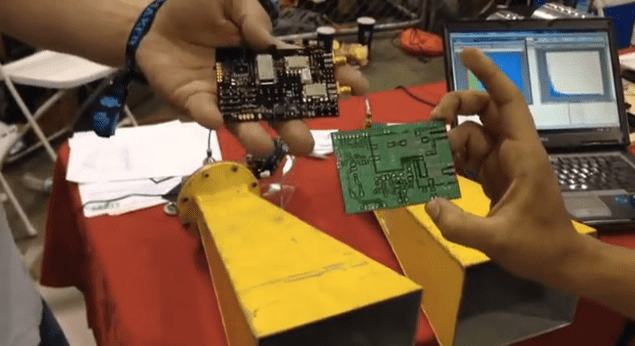The very first fully operational radar Arduino shield was recently demonstrated at Bay area Maker Faire. It was built by [Daniel] and [David], both undergrads at UC Davis.
Many have talked about doing this, some have even prototyped pieces of it, but these undergrad college students pulled it off. This is the result from Prof. ‘Leo’ Liu’s full-semester senior design course based on the MIT Coffee Can radar short course, which has been going on for 2 years now. Next year this course will have 30 students, showing the world the interest and market-for project based learning.
Check out the high res ranging demo, where a wider band chirp was used to amazing results. Video below.

















Very cool, just be sure to operate within the laws of whatever jurisdiction you live in, as any application of active radar involves transmitting RF.
This looks like a pre-existing arduino radar shield, to me:
http://reactancelabs.com/?p=293
” showing the world the interest and market-for project based learning. yet again showingWe the influence of hackers on higher education.”
Even by HaD’s editorial standards, this is diabolical. Come on chaps – at least read it through once before you post.
Or maybe they just hired Yoda.
Usually I’m not much for complaining about the grammar or spelling of articles on here… but… yeah.
Thanks Greg for posting this. I want to mention that all the design files and a final report are posted online for anyone that wants to explore further.
https://drive.google.com/folderview?id=0Bzbq9fPL-_ZRT3YxaHpGVEtWRHM&usp=sharing
My students will work on improving the design and finalizing on a version that everyone can build.
For those who like to experiment with this stuff in a simpler way, take a look at the HB100 doppler sensor module. It costs a few bucks and meets all legal/safety requirements.
The HB100 doesn’t give you much distance information though.
This is been has was show before, Ardweebo Everything has to use Ardweebo
wat
Seriously…what?!?
Brave guys using their testicles as radar reflectors. Yes, I know it’s very low power, but…
The phone you carry in your pocket has 2, maybe 3 orders of magnitude more RF power output…
RF radiation at this level isn’t going to do anything to you. It’s a myth about cops and testicular cancer and traffic enforcement radar. On a larger radar with much higher output power, kilowatts on up you might get thermal injuries and cataracts due to tissue heating, since radar typically works at microwave frequencies and work pretty much the same way as your microwave oven, though the guts may not be just a simple magnatron like in an oven. This is non-ionizing radation and does not emmit “rays” like as in x-rays or gama rays.
when the proto will be done?
All the design files are available here: https://drive.google.com/folderview?id=0Bzbq9fPL-_ZRUG1TTXZFT3Y2QUE&usp=sharing
An updated version will be available by the end of September.